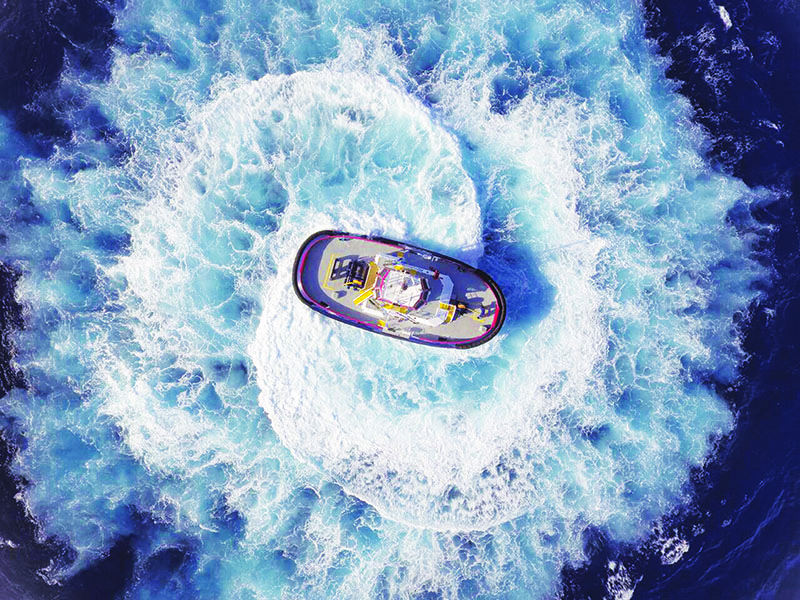Rotortugs have finally come to the U.S. after operating in other parts of the world for some time. Master Boat Builders, Bayou La Batre, Ala., delivered the first of three new 98'6"×43'6"×15'7" Robert Allan Ltd. (RAL)-designed Advanced Rotortug (ART 80-98US) tugs to Fort Lauderdale, Fla.-based Seabulk Towing in January. Seabulk is a unit of Seacor Holdings Inc.
The new tugs feature triangular propulsion designed to deliver optimum maneuverability. “We went to [Robert Allan] specifically for the Rotortug concept and they met our needs for the U.S. marketplace,” said Anthony Caggiano, Seabulk’s senior marketing manager.

The first of three new Rotortugs is working in Fort Lauderdale, Fla. H. Rick Groen/Seabulk Towing photo.
With a draft of 18'6", the ART tugs Trident and Triton (the third tug is unnamed) are scheduled to work out of U.S. Gulf and Florida East Coast ports. Trident is currently working at Port Everglades in Fort Lauderdale. The Triton is set for delivery in June and the final tug will be delivered to Seabulk in late October.
Seabulk’s ARTs are designed to bring maximum maneuverability and enhanced safety in escorting LNG tankers and other high-demand applications to the U.S. market.
Master Boat has built a series of OSVs for Seacor over the past several years and several for other operators, but the yard was looking at other markets with the offshore service industry suffering from low oil prices and an oversupply of equipment.
Master Boat has shown its diversity over the years by building fishing vessels, factory processors and other boats. “Basically, anything that floats,” said Andre Dubroc, the yard’s general manager. “We recently were awarded a contract to build six ATBs which should show off more of our ability to adapt.”
New Challenge
The Trident is the first tug built by Master Boat since the 1980s and the yard had to take a different approach than the one used to build a supply vessel, said Dubroc. “When we accepted the contract we were able to agree that Master Boat would be able to incorporate our construction techniques into the RAL design,” he said. “Working closely with Jamie McCarty of RAL, we were able to make the design easier to build, without changing any of the RAL concepts.”
This also involved the installation of equipment that Master Boat had not previously worked with such as Schottel Z-drives, JonRie towing/escort winches, and an Alphatron integrated bridge system.
The yard “had to adapt and understand how an escort tug works out in the field, which differs greatly from an OSV,” Dubroc said.
Main propulsion comes from three Caterpillar 3512C, Tier 3 diesels, producing 1,910 hp at 1,600 rpm each. The Cats connect to three Schottel SRP 1210 Z-drives. The propulsion package gives the tugs a running speed of 12.5 knots.
Whereas a typical stern-drive tug provides power from just two drive units, ART tugs have three strategically positioned azimuth propulsion units. This provides full redundancy and increased maneuverability while dividing the installed power among a trio of smaller units that combine for a guaranteed bollard pull of 80 tons, according to Seabulk.
Ship’s service power comes from twin Cat engines sparking 150 kW of electricity each. On deck are two JonRie Intertech towing winches. The forward hawser escort winch is a Series 230 outfitted with 450' of Samson 12 2-5/8"×8" HMPE rope. The aft combination towing and hawser winch is a series 500 outfitted with 2,100' of 2.25" wire rope and 450' of Saturn 12 2-5/8"×8" HMPE rope.
Aboard the Trident
Coming out of Bayou La Batre in January, the Trident first went to Seabulk’s operation in nearby Mobile, Ala., to be put through the paces. During a ride along, the new tug got its first job — escorting the cruise ship Carnival Fantasy to its berth alongside the Mobile Convention Center.

The Trident escorts cruise ship Carnival Fantasy on the Mobile River. H. Rick Groen/Seabulk Towing photo.
The Trident met up with the cruise ship as it came out of Mobile Bay into the Mobile River. The ship has its own thrusters, but the Rotortug maneuvered into position for an added layer of safety. More for practice than necessity, the Trident’s crew did make up a line for a short time. Once the line was brought back in, the captain turned the tug perpendicular to the cruise ship and followed along sideways as the cruise ship was making better than five knots.
“This tug can go up to 8.5 knots sideways,” H. Rick Groen, Seabulk’s senior vice president and CEO, said.
With the Carnival Fantasy safely docked, the Trident headed back to its berth, drawing curious eyes from other tug crews as it made its way along the river.
“This tug has no skeg. There’s no need for one on this vessel,” said Groen. “We could lose a drive unit and still continue with the two units still functioning and have a bollard pull of 51 tons.”
Once back at the dock, two people from nearby Austal USA came aboard and the Trident went back out into the river and ran sideways, then did 360° donuts, first one way and then the other.
When the Rotortug returned to the dock the second time, more people from other companies hopped aboard to see the new boat. About 15 minutes later, word came down that Trident had another job scheduled for that afternoon — escorting a containership to the port of Mobile’s container facility.
Trident has found a home at Port Everglades and is a hit with Seabulk’s captains and even its competitors.
“Each captain has their own way of running the vessel but so far all reports have been positive,” said Caggiano. “The pilots will need some time getting use to her but once they are comfortable she will really be a valuable asset to our Port Everglades harbor assist fleet. We’ve had our competitors onboard and they are highly impressed, which is a huge compliment to us.”






